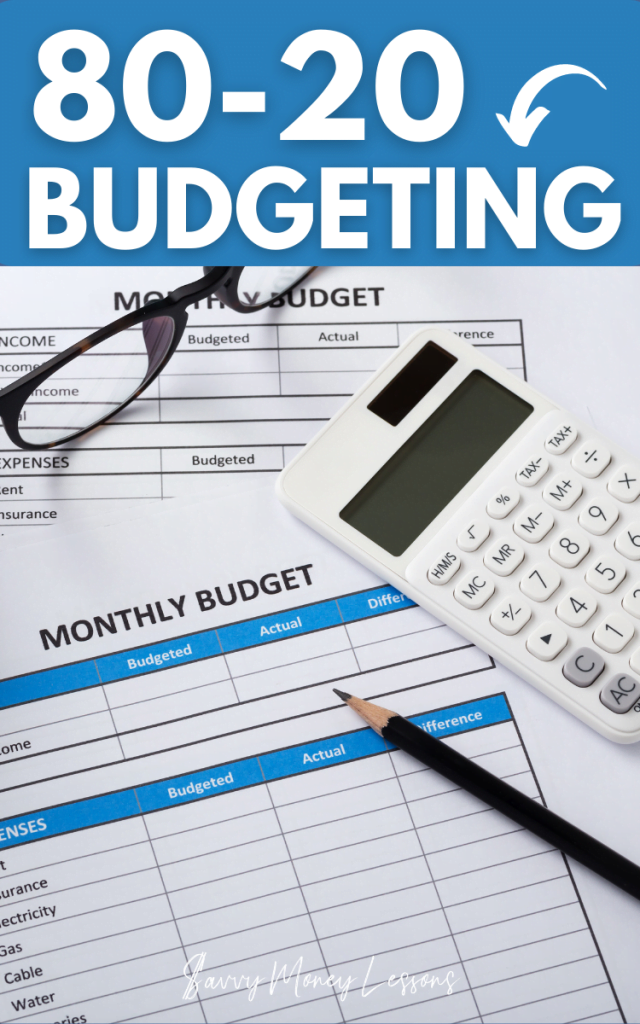10 10 80 Budget Rule: A Simple Way to Spend, Save and Give
This post may contain affiliate links, which means I may earn a small commission if you click and make a purchase. You can read our full disclosure policy here.
Last Updated on July 1, 2023 by Rebecca
If you’re looking for a budgeting method that emphasizes giving, the 10 10 80 budget is one option you might consider.
With a 10 10 80 budget rule, you give away the first 10% of income, save or invest the next 10% and spend the remaining 80%.
The 10-10-80 budget is popular in Christian personal finance circles, which encourages tithing 10% of monthly income to the church. However, you don’t need to be a Christian or have any other religious affiliation to use this budgeting method.
Is the 10 10 80 budget the best way to manage your money? Understanding how it works can help you to decide if it might be right for you.

Want free money?
Check out my favorite apps for making extra money and earning cash back!
Survey Junkie. Earn up to $50 per survey for sharing your opinions
Swagbucks. Make money playing games and watching videos ($5 bonus!)
InboxDollars. Take surveys and get paid for your opinions
Rakuten. Earn up to 40% cash back, plus get $30 for each person you refer
CashApp. Get $5 free when you use code ‘VZXRXZN’ to join CashApp
Writers Work. Earn extra cash from your writing skills!
What Is the 10/10/80 Budget System?
The 10 10 80 budget plan is a simplified way to manage money. With this budget rule of thumb, you’re dividing monthly income into three categories:
- 10% for giving
- 10% for saving/investing
- 80% for spending
Using a budgeting plan that uses percentages can be a great way to take control of your money. You can use this simple rule to work toward your financial goals while ensuring that you have enough money to pay monthly bills.
If financial stability is your ultimate goal, the 10 10 80 budgeting rule could put you in good shape.
Grow your money faster! Want to get a great rate on your savings? Open a high-yield savings account to earn the most competitive APY on deposits.
How Does a 10 10 80 Budget Work?
The 10-10-80 budget works by allocating your money into three distinct categories. This budget system makes it easy to decide how much money you’ll have in each category.
For example, say that your monthly take-home pay is $5,000. Using the 10 10 80 budget rule, here’s how much money you’d be able to spend in each category:
- $500 for giving
- $500 for saving/investing
- $4,000 for spending
The 10 10 80 rule budget doesn’t leave room for any unplanned spending. This type of budgeting approach is an uncomplicated way to manage your financial situation.

How to Make a 10 10 80 Budget
Making a spending plan using the 10 10 80 method isn’t difficult. The first step is knowing how much money you have to work with for the month.
This is where you’ll need to add up all of your take-home income for the month, which can include:
- Salary and wages earned from a 9 to 5 job
- Extra money made through side hustles or odd jobs
- Alimony or child support payments if you receive them regularly
- Government benefits
The key is to use your after-tax income; otherwise, you won’t have an accurate number to work with.
Once you know your income, you can divide it up into three buckets.
10% for giving
With the 10/10/80 budget, the first 10% of your take-home pay is supposed to go to giving.
In some churches, tithing the first 10% of income is considered an act of worship. But again, you don’t need to belong to a specific church or subscribe to any religion to give part of your income away.
You could give 10% of your earnings to your favorite charity. Or you might give on a more personal level. This is the same amount you’d give using the 70 20 10 budget rule.
For example, I belong to a local needs and seeds Facebook group. People who need financial help with things like paying their electric bill or gas bill can post there and other group members can fund those needs anonymously.
10% for saving and investing
After you set aside 10% of your income for giving, the next step is saving or investing 10%.
Your financial goals can determine where the money actually goes. For example, if you’re trying to build up an emergency fund equal to three months of expenses, then it makes sense to keep that money in a high-yield savings account.
On the other hand, if you’re focused on building retirement savings, then it makes sense to use retirement accounts instead. That might include a 401(k) plan at work, Roth IRA or a taxable investment account.
If you haven’t given much thought to your short or long term money goals, you could be short-changing your financial success. Thinking about your financial priorities can help you shape your savings goals.
Need some ideas for short- or long-term savings goals? Here are a few options:
- Save $10,000 for unexpected expenses in the next 12 months
- Set aside $25,000 for a down payment on a home over the next three years
- Open a college savings account once your kids reach high school and contribute $300 each month
- Invest $500 per month for retirement into an IRA
Any of these options could be a great goal to set. What your actual goals look like can depend on how much cash you have to save and what you want to do with your money.
But the more specific your financial goals are, the better.
Pro tip: Struggling to stay on top of expenses? Consider using a personal finance tool like Empower to track all of your financial accounts in one place.
80% for spending
The biggest bucket in the 10 10 80 budget is for spending, which is divided into three major categories: necessary expenses, discretionary spending and debt repayment.
When evaluating monthly expenses, it’s important to start with essential expenses first. These are the things you need to pay for to maintain a basic standard of living.
Your monthly spending in this category can include:
- Mortgage payments or rent payments
- Health insurance premiums
- Car insurance
- Utility bills
- Grocery shopping and basic food items
- Child care if you need to pay for that in order to work
Discretionary spending means anything you spend money on that isn’t an essential expense. So, in this category, you might include:
- New clothes
- Dining out
- Self care or non-essential health care that insurance doesn’t cover (like cosmetic treatments or spa days)
- Hobbies and recreation
- Entertainment
- Travel
The third category includes anything you spend on debt repayment. Depending on your financial situation, that might include:
- Credit card minimum payments
- Car payments
- Student loans
- Other outstanding debts, such as personal loans
If you have credit card debt and getting rid of it is a top priority, then you might allocate more of your budget to those debts. And keep in mind that if you’re paying the minimum debt payment to your cards, it can take a lot longer to pay it off.
Pro tip: Transferring credit card balances to a card with a 0% APR could help you pay off what you owe faster. You can compare card offers and check your credit score for free at Credit Karma.

Ready to get your budget together?
Grab our monthly budget worksheet, spending tracker and debt repayment tracker when you join the Savvy Money Lessons email list!
Does the 10-10-80 Budget Work?
The 10 10 80 budgeting method could be a good option if you’ve got your spending habits under control and you’re looking for a simple way to make a monthly budget.
On the other hand, you might prefer a different system if you’re looking for a more structured budget plan.
Here are the main pros and cons to know.
| 10 10 80 Budget Advantages | 10 10 80 Budget Disadvantages |
| It’s easy to make a monthly budget and spending plan using percentages. You have the freedom to decide how to give, how to save or invest and how to spend, without being locked in to more rigid budget categories. Anyone can make a 10 10 80 budget if they know their take-home pay and have a calculator handy. | The 10 10 80 budgeting method isn’t as precise as other budget systems. If you’re not careful about tracking spending, it can be easy to overspend. Budgeting with this method may be more difficult for people with irregular income. |
10 10 80 Budget Alternatives
The 10 10 80 rule isn’t the only way to make a budget. If you’re trying to find the right money management system, here are a few other creative ways to do it.
50-30-20 rule
The 50 30 20 rule is a budget method developed by Senator Elizabeth Warren and her daughter, Amelia Warren Tyagi, in their book “All Your Worth: The Ultimate Lifetime Money Plan”.
With the 50-20-30 rule, 50% of your income goes to needs, 30% goes to wants and the remaining 20% goes to your financial goals. It’s similar to the 10 10 80 rule, since you’re budgeting by percentages, but it uses a different allocation.
Zero-based budget
The zero-based budgeting system was popularized by Dave Ramsey, best known for developing the baby step method of saving, paying off debt and building wealth.
With a zero-based budget, you’re giving every dollar of income a job. Once you create your spending plan, there should be no money left over.
This kind of budget system might appeal to you if you’re using the envelope system to manage discretionary spending.
Cash envelope budgeting
The cash envelope budget method is just what it sounds like: a budget system that requires you to spend cash.
Here’s how it works.
- You decide how much money to commit to discretionary spending your budget.
- You withdraw that amount from your checking account in cash at the beginning of the month.
- That cash gets divided up into different envelopes for nonessential expenses, like dining out or self-care.
- Once you spend all the cash in an envelope, you can’t spend any more money in that budget category for the month.
You might like the cash envelope method if you’re comfortable pulling money out of your bank account in one go and you’re committed to tracking your spending carefully. If you’d rather not carry around large amounts of cash, you can try a digital cash envelope budgeting app instead.
Recommended Budget Binders
10/10/80 Budget FAQs
What is the 80 10 10 rule money?
The 80 10 10 rule of money is a budget method that advocates spending 80% of your income, saving or investing 10% and giving 10% away. One of the main purposes of this type of budget is to ensure that you have plenty of money to cover your essential expenses while prioritizing charitable or church giving.
Is the 10 10 80 rule budget just for Christians?
While the 10 10 80 rule is popular among churches and other nonprofit organizations that prioritize giving, it’s not exclusive to people who ascribe to a particular religion. Anyone can make the 80 10 10 money rule work if they’re able to calculate percentages and know how much after-tax income they have to work with.
What’s the best way to save and invest with the 10 10 80 rule?
How you invest 10% of your income each month is up to you and there are a range of financial products to choose from. If you want to keep things simple, then you might start with a high-yield savings account or CD account at your bank. On the other hand, you might venture into the stock market or make real estate investments if you’re comfortable taking more risk. Talking to a certified financial planner or financial advisor can help you decide on a saving and investing plan that works for you.
Is the 80-10-10 rule the best way to budget?
The best way to budget is the one that fits your financial situation and goals. With that being said, the 10 10 80 rule may not work for everyone. The good news is that you can experiment with different budgeting systems to find the one that’s right for you. For example, you prefer 80/20 budgeting or 70 20 10 budgeting instead.
Ready to start saving? Try the 100 Envelope Savings Challenge and discover that saving money is easier than you think!
Final thoughts on 10 10 80 budgeting
Making a budget matters when you’re trying to achieve financial security. You might think there are better things you can do with your time but spending an hour or two each month to plan out your spending can go a long way when you’re trying to get ahead financially. If you’re looking for an easy way to budget that allows you to work toward multiple goals at once, you might consider giving the 10 10 80 rule a try.
Need more money tips? Read these posts next:
- 30 30 30 10 Budget Rule: A Simple Way to Spend and Save
- How to Make a Budget in 5 Easy Steps
- Importance of a Family Budget and How to Make One
Have you tried the 10 10 80 budget method?
About the Author
Rebecca is a certified educator in personal finance (CEPF) and a money-saving expert. As a single mom of two teens, she knows all about the importance of family budgeting and financial goal-setting. She shares her best tips about saving and managing money at Savvy Money Lessons. You can also read her work online at Bankrate, Forbes Advisor, Investopedia and other top publications. Learn more









![Financial Planning for Families Checklist [2023]](https://savvymoneylessons.com/wp-content/uploads/2023/03/Important-Lessons-to-Teach-Kids-About-Money-640x1024.jpg)
![Gardening to Save Money [8 Smart Tips to Cut Your Food Budget!]](https://savvymoneylessons.com/wp-content/uploads/2021/06/Gardening-Tips-to-Save-Money-640x1024.jpg)



4 Comments